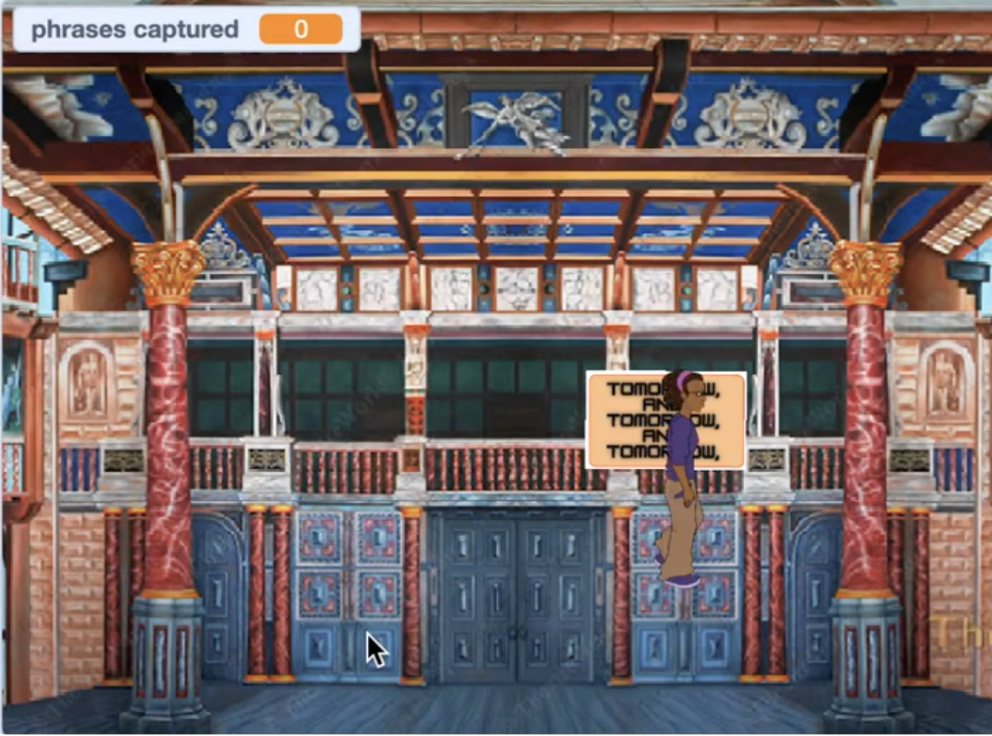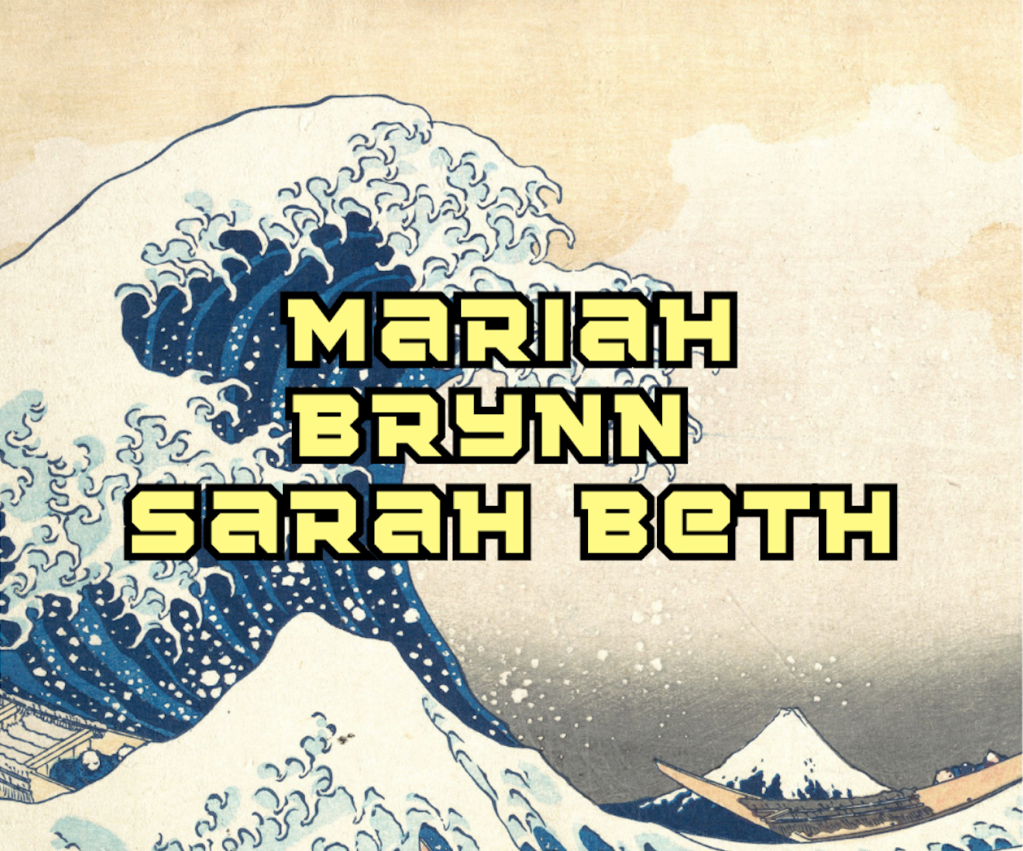
Introduction
For our game design project, we were particularly inspired by Gabrielle Zevin’s novel Tomorrow and Tomorrow and Tomorrow, a book about game-making, friendships, and lives lived together & in conflict. We were particularly inspired by the passion, creativity, and care that Sadie and Mazer put into each game they created over the course of the novel, even as they struggled with their relationships with one another. In creating our game, we wanted to remediate the novel by pulling together aspects of two different games that Sam & Sadie made: EmilyBlaster and The Master of Revels, in order to touch on the importance of the name of the book & explore more deeply the scenes within it. This led us to create our game, MarxBlaster.
What Our Game Is
MarxBlaster is a remediation of two games, EmilyBlaster and Master of Revels, from Zevin’s novel. EmilyBlaster is a first-person shooter game, one of Sadie’s early games described in the book, where the player shoots down phrases from Emily Dickinson’s famous poems in order to assemble the finished works. In Master of Revels, the game is set in Shakespearean London, where the gamer has to discover who killed the playwright Christopher Marlowe. Our game remediates, in part, a section of the game Sadie created an actor styled after her deceased partner Marx, who gives the “Tomorrow & Tomorrow & Tomorrow” speech from Shakespeare’s Macbeth, the same speech that the novel is titled after. We combined the two games by borrowing the scene and the speech from the Master of Revels scene while placing additional emphasis on phrases like Sadie did in EmilyBlaster. In our game, the player is tasked with navigating the Globe Theater in order to find her friend Marx, who is preparing to deliver the “tomorrow and tomorrow and tomorrow” speech. Over the course of several levels, you must collect speech bubbles containing the lines from Marx’s speech while moving through various rooms of the theater, including the light room, a makeup room, on the side of the stage, and at the end, meeting Marx on the main stage. The speech bubbles constantly change speed to increase difficulty as the game progresses. Upon collecting all the speech bubbles, the player completes the game by reaching Marx, who then performs his speech before the audience (and the player).
At the end of the game, a voice (voiced by our group member, Sarah Beth) reads the speech aloud. The screen switches to the lines of the speech displayed and read together for the first time in front of an image of Under the Wave off Kanagawa, also known as The Great Wave, by Katsushika Hokusai – the same image referenced on the cover of the book alluding to the iconography in Ichigo – Sadie & Sam’s first game.

Game Design & Our Process
In designing this game, we tried to balance what scenes we thought would be interesting to remediate with our group’s game-making inexperience. Originally, we were deciding between our final project idea, inspired by our love of Marx, or trying to recreate one of Sam’s mazes in LA, with several dead-ends referencing core plot points of the novel. In learning more about game-making, we decided a platformer game would be within our skill level while still having the capacity to remediate the work how we wanted to. In placing Marx’s character directly in our game, we remediated the novel by both featuring games & scenes in the work, but we also remediated Sadie’s love letter to Marx by placing him in our game, just as she placed him in hers.
Once we decided on MarxBlaster, we tackled the design of the obstacles to reaching Marx. This is where we took inspiration from the mechanics of Sadie’s game EmilyBlaster. We used the concept of shooting phrases to create the obstacles to getting individual lines of the “tomorrow and tomorrow and tomorrow” speech but implemented it within the platformer rather than as a shooter game. We decided to use the platform Scratch, as none of us had any coding experience. Because our concept was more complex, we tried to balance it with the simpler system in order to add in all the details we wanted to, such as moving from scene to scene through the Globe Theater and with our moving text boxes.

Visually, we decided to use photos from the inside of the Globe Theater in order to give the player the feeling of walking through the game. We made text boxes that simulated text we associate with classic video games and tried to reference the font used on the cover of the novel in the process, especially considering the phrases the game’s main character collects to reference the speech.
Our character design was based in part on convenience and in part on the type of remediation & game we wanted to create. There are only two characters in the game: Marx & the main character. Marx’s character was chosen mainly because the sprite was dressed appropriately for an actor in Macbeth. The main character was chosen for some of the same reasons: she was an existing sprite that had good costumes available, especially to animate her while she walked. However, part of our motivation was also because, as we’ve talked about in class, there is a lack of diverse representation in video games, and we wanted to challenge some of those notions in our protagonist selections, especially because race & representation are hugely important themes in Zevin’s novel.

Our entire group collaborated on the design of the game. Mariah did the majority of the coding, especially around creating the stages, coding each sprite’s movement, creating the beginning & end sequences, and figuring out how the text boxes would move. Brynn did most of the graphic design work, especially in the end scene & with the text boxes, and coded the movement between scenes, the point value system, & switched the text between levels. Sarah Beth helped with finding the scene pictures and created our trailer.
Successes & Challenges
In terms of concept, our game was very successful. Our finished product does what we set out to do: we have multiple levels the protagonist goes through, the text bubbles move with varying speeds and difficulty, the introduction & end of the game align in terms of our messaging of the game, and we were able to create text bubbles that disappear when touched and add points at the top left of the screen. Our game was also successful in that we learned a lot about game-making and just how much goes into it – although Scratch is certainly a simpler tool, we were able to use it to learn more about game mechanics and foundational lessons around game-making. Marxblaster is certainly not without bugs, and because of time and experience constraints, it is not as difficult or complex as we may have wanted it to be, it is cohesive in terms of the story we wanted to tell through game-making and the way in which we wanted to remediate core aspects of the novel.
Along the way we did have a lot of difficulties. Learning to code with zero experience between the three of us led to a huge learning curve. We had a lot of difficulty even getting our game to save our progress in Scratch because too many of us were signed in, leading Mariah to have to recreate more complex sequences of code multiple times. Although the simplicity of Scratch was why we chose the program, at times, it also was too simple for us, and we had to come up with workarounds to the software in order to get our game to do what we wanted it to do. Additionally, we had a lot of issues with our text boxes and changes between our six total scenes. We had to come up with a bit of a convoluted workaround that led to some of the boxes running across the screen upside down, and difficulty in keeping them on screen in order for players to be able to collect points. For a while, we struggled to get the player to progress through the game and had to switch around our mechanics; first, when the player touched every text box they would switch screens, and then we moved to a model where when Avery touches an x-value on the right end of the screen, the backdrop switches and a new level begins.
What We Learned
We learned a lot about how difficult game making is, but also how unique a tool it is for remediation & storytelling. As we discussed in class, game type has a lot of impact on the feeling someone has playing a game; in LOTRO, the ability of players to never have to beat Sauron while enjoying the world of Middle Earth creates a far different atmosphere from that of the book & movie, which draw on the imagery of fated heroes on impossible journeys. In our game, we tried to use the platform game type and the remediation of text as a backdrop to MarxBlaster, creating a game that anyone could play but that a reader of Tomorrow & Tomorrow & Tomorrow would get a lot more out of. Games allow for multiple levels of remediation: we were able to combine aspects of two different games described in the novel, several major plot points in it, and Shakespeare’s Macbeth into one project. Although it’s far from polished or complex, we hope the nuance within our concept and the variety of scenes you experience offers an interesting game to play!
Trailer
Thanks everyone!


You must be logged in to post a comment.